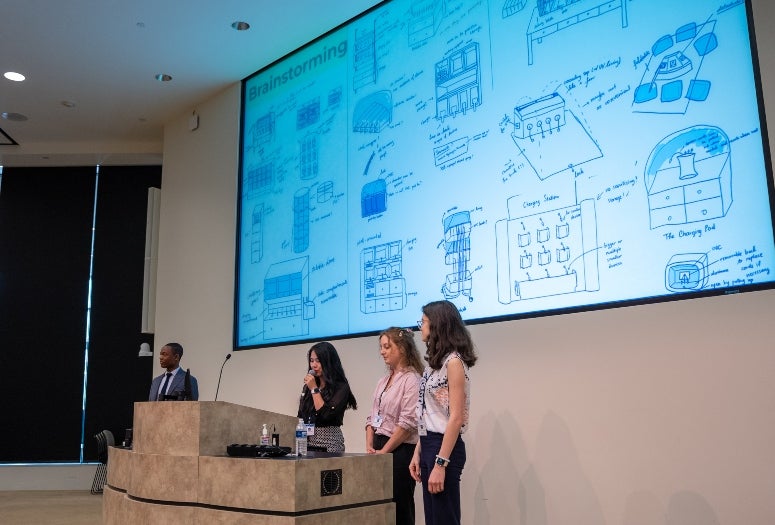On a hot July day in Rice’s BioScience Research Collaborative, a group of undergraduate students gathered to show off their work on everything from an artificial hand developed to help a boy play basketball to a device designed to automatically test wastewater in Nigeria for signs of COVID-19.
Rice University’s Rice360 Institute for Global Health Technologies and Oshman Engineering Design Kitchen (OEDK) this summer merged two internship programs and brought together 17 students over the course of seven weeks to employ inventive engineering design methods tackling health technology challenges. The Summer Experience in Engineering Design (SEED) and Rice360 interns recently showcased their work among classmates and program sponsors.
“The goal of this internship is twofold,” said Ashley Taylor, Rice360’s director of education. “We deeply believe and have witnessed that students can create real-world impacts with their innovations. The summer internship allows us to do that in a really powerful way with a full-time focus on projects.”
“The second and maybe even bigger goal is to empower students to identify problems in their communities and to cultivate a skill set to derive solutions for those problems,” she continued. “In the long term, it is not just an investment in the projects we are working on now but also an investment in their ability to face future complexities.”
Divided into five groups, the students represented academic majors ranging from social policy analysis to health sciences. But the interdisciplinary teams remained united by the program’s goal.
To pick the projects for this summer’s program, OEDK, Rice360 and industry partners looked through a pool of proposals and developed a one-page sketch of each entry. From there, the interns scoped the assignments based on their skill sets, interests and the timeline of the program. Three design mentors, who were part of the program’s 2021 summer cohort, coached the teams and provided guidance throughout the term.
The teams ended up working on these projects:
COVID-Cooler: Automatic wastewater sampler for COVID-19 testing in Nigeria
Due to low COVID-19 vaccination rates in sub-Saharan Africa, much of the continent’s population remains at serious risk. Nigerians need a device that periodically and automatically collects samples of wastewater to more efficiently test for the disease’s prevalence in their country. The team enhanced a prototype wastewater sampler by making it more portable, cost-efficient, adaptable and easier to use.
H&H: Haptic helmet
Imagine parallel parking an automobile that uses sensors to monitor the distance of nearby objects like other vehicles or a street curb. Now imagine a cellphone that vibrates in patterns to alert its user whether a text or email arrived. The haptic helmet prototype, designed for military use, combines these two sensory experiences to alert service members of approaching danger.
NESTation: Clinical hub for handheld devices
In many of Africa’s medical facilities, doctors, nurses and other staff often charge their medical devices in suboptimal conditions because they don’t have enough space or power outlets. Sanitation issues may arise from this practice, causing even more problems for preventing and controlling infection. The team created two versions of a low-cost storage and charging unit furnished with UV-C LEDs capable of sanitizing various handheld medical and consumer devices in low-resource facilities.
NIMBS: Neonatal instructional model for Ballard scoring
This project developed a clinical training model for the Ballard score, which allows clinicians to estimate gestational age — the duration between conception and birth — of newborns based on physical and neuromuscular maturity. To provide medical staff the hands-on training to properly gauge a Ballard score, the team developed an infant-sized dummy equipped with a system of strings and springs simulating various stages of indicators such as flexibility and muscular recoil to determine the newborn’s gestational age.
Flick the Wrist: Creating a prosthetic hand to play basketball
This project prototyped a prosthetic hand for a 6-year-old boy. Symbrachydactyly is a condition of short fingers that may be webbed or joined. Peromelic symbrachydactyly is the most severe form of the condition; children born with it either do not develop fingers or they are severely stunted and malformed. With his prosthetic hand, the boy can now perform basic basketball maneuvers and withstand impact associated with the game.
Rising sophomore Gloria Ni, a bioengineering major, said her experience in the program has influenced her career trajectory.
“This experience had a huge effect on me,” she said. “Being able to work on a project of high impact inspired me to pursue engineering design projects in the future. I enjoyed being able to work in a collaborative setting, and I hope to continue this type of work in my community.”
Taylor seconded that sentiment, highlighting the internship’s value in fostering future innovation.
“It is inspiring to see these student innovators tackle tough problems,” Taylor said. “Their motivation and fundamental belief that we can confront complex problems effectively, even if incrementally, help to spur meaningful progress.”
Interns bring innovative design to health technology engineering challenges
Creativity abounds during annual student showcase

Body
